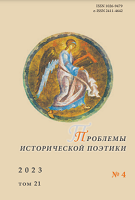Новозаветные метафоры моря и огня в «Пирамиде» Л. М. Леонова
New Testament Metaphors of Sea and Fire in “Pyramid” by L. M. Leonov
Author(s): Alexander A. DyrdinSubject(s): Christian Theology and Religion, Aesthetics, Russian Literature, Hermeneutics, Ontology
Published by: Петрозаводский государственный университет
Keywords: Pyramid; L. Leonov; hermeneutics; gospel metaphor; New Testament; philosophical and symbolic thinking; accretion metaphors of the sea and fire;
Summary/Abstract: The article is devoted to the study of the Gospel metaphor in L. M. Leonov’s novel “The Pyramid” (1940–1994). The theme of associative and symbolic nature, religious, mysterial, and metaphorical context of the writer’s works is at the initial stage of research. The study material comprised the sea and fire metaphors, as well as other metaphorical images taken from the three synoptic Gospels of the Russian Synodal Bible, as well as the Revelation of John the Theologian with their abundance, miracles, visions and prophecies. Certain features of metaphorization in the “Pyramid” related to the philosophical and artistic essence of Leonov’s creative persona, ontologically sharpened vision of man and the world are studied. The proposed observations are of a preliminary and fragmentary nature. The task of the work is to reveal the metaphors that have become the most important element of Leonov’s artistic thinking and style. The methodology of the article is integrated with the Christian tradition of interpretation of the Old and New Testaments, patristic hermeneutics, and modern ideas about metaphor. The author uses cognitive and linguistic tools, as well as the modern studies of metaphor, to comment on the metaphorical images of the Gospel. The unity of the writer’s spiritual and aesthetic experience is revealed in the suprastructural figurative system generated by the craving for symbolization of events and characters. The metaphoric images of the novel serves as a bridge between the content of the Gospel canon and the author’s artistic logic, materialized in a chain of transformed biblical allegories, parables, and prophecies. In the text of the novel, they are replaced by metaphorical idioms that have a syncretical synthesized integrity. Leonov’s accretion metaphors form a new metaphorical field. Without losing their original spiritual and moral semantics, they become self-sufficient. Leonov’s philosophical and aesthetic intuition, which integrates different levels of reality and generates additional meanings . We can talk about the combination of metaphors , the double metaphor, the mixed, non-contradictory metaphor that unfolds in the novel and forms the basis of the narrative system. The result of the semantic explication of the direct Gospel metaphor was the assimilation of the meanings given by the Gospel text. With the help of extended metaphors and paraphrases, Leonov signifies the key ideas of the Pyramid. The main one is the tragic shifts in national destiny caused by the apostasy from Orthodoxy, from the foundations of Russian cultural identity. The metaphors considered in the article are graphically highlighted in the text of the “Pyramid.” Graphic accents in phrase metaphors are essential for the reader’s perception of the work. Metamorphic image archetypes of the Way, the Ship, and the Truth highlight the ideological and philosophical depths of Leonov’s last work.
Journal: Проблемы исторической поэтики
- Issue Year: 21/2023
- Issue No: 4
- Page Range: 324-348
- Page Count: 25
- Language: Russian

